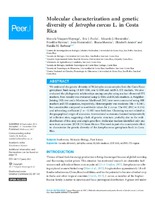Molecular characterization and genetic diversity of Jatropha curcas L. in Costa Rica
Fecha
2017Autor
Vásquez-Mayorga, Marcela
Fuchs, Eric
Hernández, Eduardo
Herrera, Franklin
Hernández, Jesús
Moreira-González, Ileana
Arnáez-Serrano, Elizabeth
Barboza, Natalia
Metadatos
Mostrar el registro completo del ítemResumen
We estimated the genetic diversity of 50 Jatropha curcas samples from the Costa Rican
germplasm bank using 18 EST-SSR, one G-SSR and nrDNA-ITS markers. We also
evaluated the phylogenetic relationships among samples using nuclear ribosomal ITS
markers. Non-toxicity was evaluated using G-SSRs and SCARs markers. A Neighbor-
Joining (NJ) tree and a Maximum Likelihood (ML) tree were constructed using SSR
markers and ITS sequences, respectively. Heterozygosity was moderate (He D 0.346),
but considerable compared to worldwide values for J. curcas. The PIC (PIC D 0.274)
and inbreeding coefficient (f D0:102) were both low. Clustering was not related to
the geographical origin of accessions. International accessions clustered independently
of collection sites, suggesting a lack of genetic structure, probably due to the wide
distribution of this crop and ample gene flow. Molecular markers identified only one
non-toxic accession (JCCR-24) from Mexico. This work is part of a countrywide effort
to characterize the genetic diversity of the Jatropha curcas germplasm bank in Costa
Rica.
Fuente
PeerJ 5:e2931; DOI 10.7717/peerj.2931Compartir
Métricas
Colecciones
- Artículos [40]


